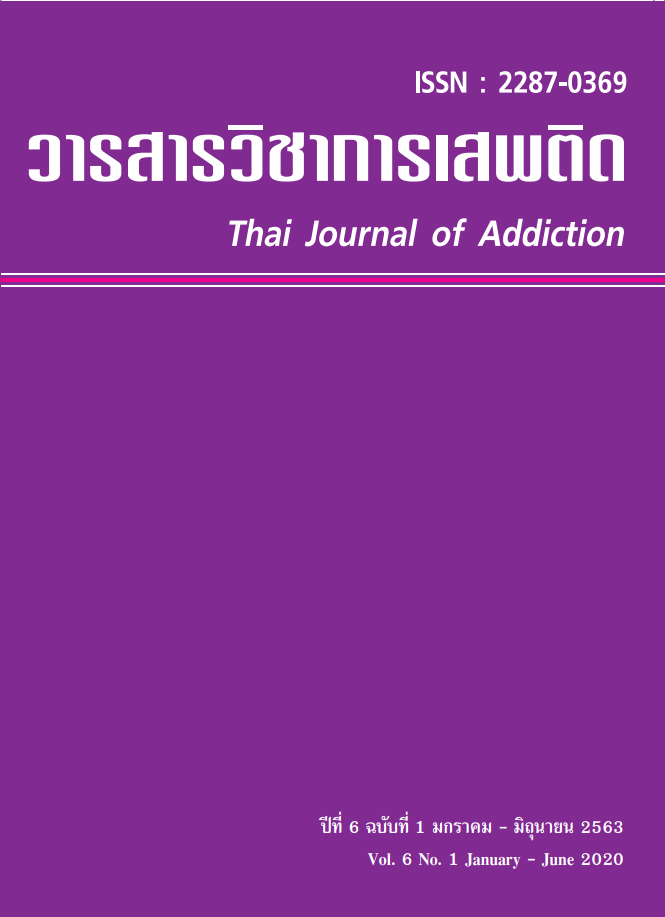Factors associated with new addicts in the voluntary treatment system
Keywords:
Voluntary system, New and old drug usersAbstract
The study was descriptive research. The aim was to study factors and information associated with drug use among new - treated case. The data collection was drawn from 1,491 patients who were in the voluntary drug treatment system during 2014 - 2016. One thousand seventy-three patients were new cases appearing in the online report system of the monitoring and surveillance for drug problems, Ministry of public health. Descriptive statistics including frequency distribution and percentage was applied for analyzing data. To compare the ratio of the differences between the two groups of drug addicts between the new case and the old case, test the chi-square test was analyzed the comparison the difference at statistically significant differences at P <0.05.
Result: The results indicated that 2014 to 2016 has the highest number of voluntary patients, 1,491 people following with compulsory system, 1,096 people and the criminal justice system, 386 people, respectively. The number of the patient from the voluntary system tended to be increasing, and those were the new case being higher than the old case approximately triple times. Mueang Lamphun District, Ri District and Mae Tha District were the top three areas, with many new patients admitted every year.
Factors related to substance use in new patients in terms of personal information of substance users are gender, age, marriage, education, religion, occupation, and parent relationship. While the substance use information includes first use, reasons for use, age of first use, reason for treatment and results. Those factors significantly correlated with drug use in new case p < 0.05. Income was the only factor that did not correlate with substance use among those patients.
Conclude and discussion: This study found significant opportunities for utilization by explaining problems related to new substance users. These factors are divided into two parts: patients, families and personal relationships. High-risk patients that should be supervised and prevented were males aged 16-25 years old and education level was high school. Family and personal relationships also effect on drug use. Therefore, an integrated treatment model should be created to control the risk factors involved in all dimensions, focusing primarily on the family unit and the patient-related environment.
Suggestion: Governments should formulate policies that support love warmth and the role of family units in concrete form, in building immunity and increasing defensive from the external environment.
References
(Service plan) สาขายาเสพติด. บริษัท บอร์น ทู บี พับลิชชิ่ง จำกัด; 2561.
2. สำนักงาน ป.ป.ส.กระทรวงยุติธรรม. รายงานผลการดำเนินงานป้องกันและแก้ไขปัญหายาเสพติด
ปีงบประมาณ 2558. กรุงเทพฯ : สำนักงาน ป.ป.ส.; 2558.
3. สำนักงานสาธารณสุขจังหวัดลำพูน.สรุปผลการดำเนินงานด้านการบำบัดฟื้นฟูประจำปี
2557 – 2259. ระบบ รายงาน บสต.ปีงบประมาณ 2557-2559 และรายงานการประชุมคณะกรรมการ
ศูนย์อำนวยการป้องกันและปราบปรามยาเสพติดจังหวัดลำพูน ปีงบประมาณ 2257-2559.
4. แผนงานการพัฒนาระบบการดูแลผู้มีปัญหาการดื่มสุรา (ผรส.).การป้องกันการใช้สารเสพติดในเด็ก
และวัยรุ่น.วนิดาการพิมพ์; 2556.
5. สำนักงาน ป.ป.ส. และกระทรวงสาธารณสุข.คู่มือการใช้งานระบบข้อมูลการบำบัดรักษาและฟื้นฟู
ผู้ติดยาเสพติดของประเทศ (บสต.); 2559.
6. ประกาศคณะรักษาความสงบแห่งชาติ ฉบับที่ 108/2557. การปฏิบัติต่อผู้ต้องสงสัยว่ากระทำผิดตาม
กฎหมาย เกี่ยวกับยาเสพติดเพื่อเข้าสู่การบำบัดฟื้นฟูและการดูแลผู้ผ่านการบำบัดฟื้นฟู.;21 กรกฎาคม
พ.ศ. 2557.
7. สำนักงาน ป.ป.ส.กระทรวงยุติธรรม. แผนประชารัฐร่วมใจสร้างหมู่ชุมชนมั่นคงปลอดภัยยาเสพติด
พ.ศ.2559-2560.
8. ศูนย์อำนวยการป้องกันและปราบปราบยาเสพติดจังหวัดลำพูน.สรุปผลงานประจำปี 2557.
9. พนม จอมอินตา.การศึกษาเปรียบเทียบผลสำเร็จของการบำบัดรักษาผู้ป่วยยาเสพติดระบบสมัครใจ
จังหวัดลำปาง ปี 2553-2555. สำนักงานสาธารณสุขจังหวัดลำปาง; 2556.
10. ชุติมา พัฒราช. การศึกษาความสัมพันธ์ระหว่างปัจจัยบางประการกับเจตคติต่อการใช้ยาเสพติดของ
นักเรียนชั้นมัธยมศึกษาปีที่ 3. (วิทยานิพนธ์หลักสูตรปริญญาการศึกษามหาบัณฑิต) กรุงเทพฯ :
มหาวิทยาลัยศรีนครินทรวิโรฒ; 2546.
11. กนกรัตน์ แจ่มวัฏกูล. การศึกษาปัจจัยด้านครอบครัวและกลุ่มเพื่อนที่มีต่อการเสพยาบ้าของเด็กและ
เยาวชน. (วิทยานิพนธ์ปริญญาการศึกษามหาบัณฑิต). กรุงเทพฯ : มหาวิทยาลัยศรีนครินทรวิโรฒ;
2545.
12. อินทร์ทิพย์ อินทรสุข และคณะ. บทบาทของครอบครัวในการดูแลผู้ป่วยยาเสพติดหลังการบำบัดใน
กลุ่มเสพซ้ำ. วารสารวิชาการเสพติด. 2556; 1(1): 32-43.
13. ธนิตา หิรัญเทพ และคณะ.การศึกษาปัจจัยที่สัมพันธ์กับการไม่เสพยาเสพติดซ้ำในผู้เข้ารับการบำบัด
ในระบบบังคับบำบัดปี 2551-2552 .วารสารสมาคมจิตแพทย์แห่งประเทศไทย. 2556; 58(2):
157-164.
14. แผนงานการพัฒนาระบบการดูแลผู้มีปัญหาการดื่มสุรา (ผรส.).มาตรฐานสากลในการป้องกันการใช้
สารเสพติด. วนิดาการพิมพ์; 2556.
15. จิราภรณ์ ลิ่มนิจสรกุล.ปัจจัยเสี่ยงและปัจจัยปกป้องการเสพติดสารแอมเฟตามีนในวัยรุ่น.
(วิทยานิพนธ์พยาบาลศาสตรมหาบัณฑิต). เชียงใหม่ : มหาวิทยาลัยเชียงใหม่;2546.
16. จรูญศรี โคมพุดซาและ ชัยภัทร ธีรชาญไชย. ปัจจัยที่มีความสัมพันธ์กับการบำบัดครบกำหนดของ
ผู้ใช้สารเสพติดในระบบสมัครใจ จังหวัดนครราชสีมา ปีงบประมาณ 2555-2556.สำนักงาน
สาธารณสุขจังหวัดนครราชสีมา;2556



